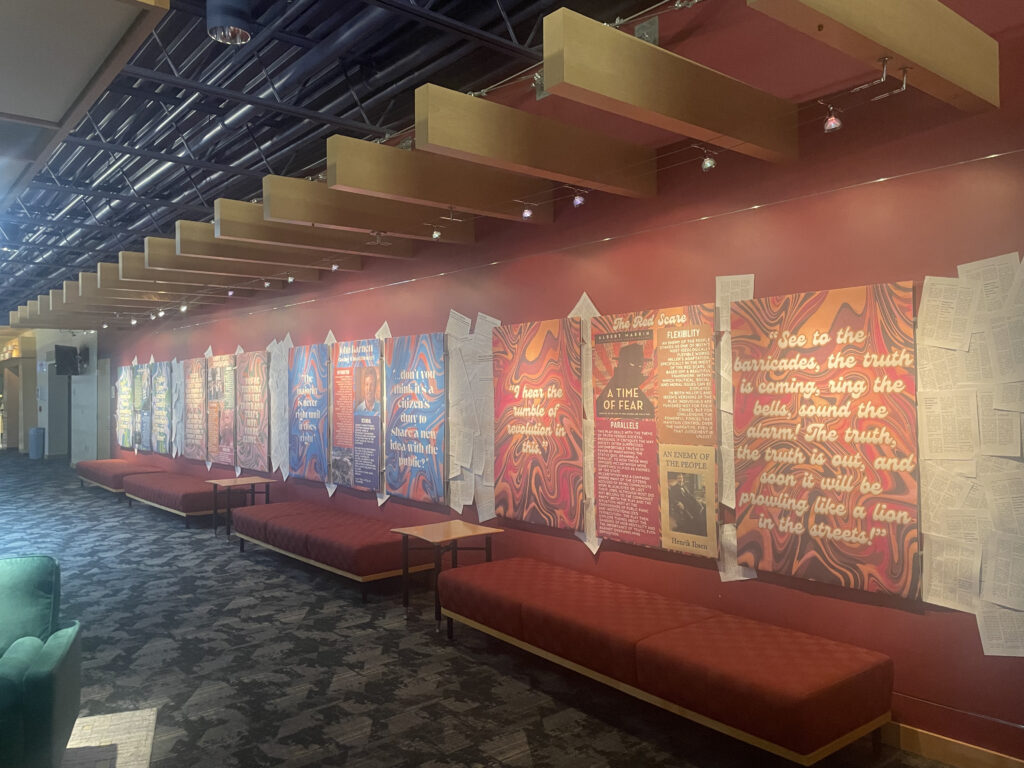In the past few weeks, trash cans with brightly colored letters have popped up on campus. What might look like ransom note lettering is actually part of a creative endeavor for the Theatre Department’s upcoming play, “An Enemy of the People,” by Henrik Ibsen and adapted by Arthur Miller. The play follows a town that has to make a decision between environmental integrity and maintaining the status quo. Though the play was written in the late 19th century, its content is applicable and relevant to this day. To reinforce the timeliness of its message, Director Molly Wiebe Faber is using the play’s storyline as inspiration to create interactive and creative elements between the audience and actors. The extra visual ideas represent the creative ownership of the director, as well as trust in the student production team to realize her vision.
Though the production crew is keeping some of the elements a surprise, many students are aware of the incorporation of used materials in the play. Posters and chapel slides encourage students to deposit their trash into the bins so that it can be used for the set of the play. Students that donated their garbage might see it on stage during the performance, which adds a level of ownership and connection between the audience and actors. In addition to seeing oneself represented on stage, there are also moments in the play where the actors directly interact with the audience. When attending, be on the lookout for items being handed to people watching the show, or moments when the action is happening not just in front of the audience, but in it.
The creative choices are not limited to the Black Box Theatre, but they even extend into the lobby. From the moment audience members step into the building, they are immersed in the context of the show. There are musicians playing protest tunes from the era, dramaturgy explanations of the historical significance of the show and a functional water spring that is a reference to the main conflict of the play. In addition to Wiebe Faber’s creativity, theatre students are also allowed to exercise their own in creating the lobby atmosphere. All of these moving pieces are planned and executed by the designers of the show, which is often a student-led endeavor. The Theatre Production Ensemble is largely in charge of the brainstorming and production process, which helps to build student ownership and skills relating to putting on a play. Attendees are encouraged to arrive early to enjoy the sights and sounds before the show starts.
There are, of course, obstacles that get in the way of executing the creative vision to its fullest. For instance, theatre work study student Lexi Squier wishes the signs would have clarified that the department was seeking dry trash, as to avoid some unpleasantness when sorting and working with the materials. Also, last-minute ideas mean crunched deadlines and late nights to make sure that all the pieces are ready in time. However, many of the theatre students say that it has been worth the extra effort. Emily Espinoza an actress in the show, says that the creative elements have added greatly to the process of putting this play together. “I think it makes an already timely play that more timely in the way the artistic choices are made,” said Espinoza. “The use of trash, the use of ethically-sourced materials and props and costumes, everything in the show was used to promote environmental awareness and sustainability. We barely bought anything – we either made it ourselves, borrowed it or used what we already had.”
The use of found and made materials reinforces the message of the show and demonstrates the Theatre Department’s commitment to practicing what they put on stage. “An Enemy of the People” is running throughout the weekends before and after Easter. Even those who do not feel particularly drawn to the theatre can appreciate all the student effort that went into the production, as well as the relevancy of the show’s message.

Posters advertising for “An Enemy of the People.”